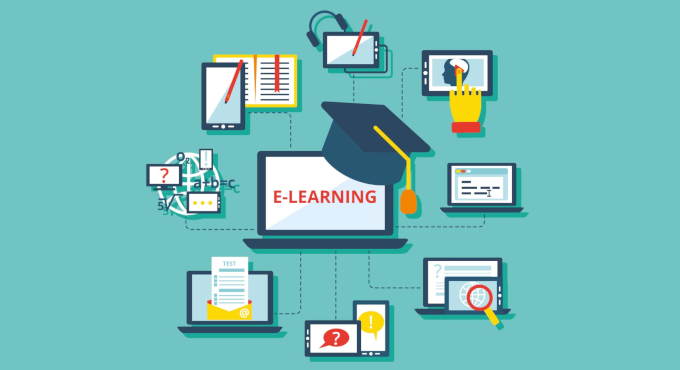
In the digital age, e-learning has emerged as a transformative force in education. The convenience, accessibility, and adaptability of online learning platforms have revolutionized how knowledge is acquired and shared. From high school classrooms E-learning to corporate training programs, e-learning has expanded educational horizons and democratized learning opportunities. This article explores the evolution, impact, and future potential of e-learning, highlighting its benefits, challenges, and emerging trends.
The Evolution of E-Learning
Early Beginnings
The origins of e-learning can be traced back to the 1960s with the development of computer-based training programs. These early systems, often limited to large institutions and specialized industries, laid the groundwork for what would become a vast digital education landscape. The 1990s marked a significant leap forward with the rise of the internet and the creation of Learning Management Systems (LMS) like Blackboard and Moodle. These platforms allowed for the delivery of educational content online, making it accessible to a wider audience.
The Mobile Revolution
The early 2000s saw the advent of mobile learning (m-learning), driven by the widespread use of smartphones and tablets. This innovation allowed learners to access courses and educational materials anytime and anywhere, further breaking down traditional barriers to education. The integration of social media platforms also facilitated collaborative learning, enabling students to interact and share knowledge in new and dynamic ways.
Current Innovations
Today’s e-learning landscape is characterized by advanced technologies that enhance the learning experience. Notable innovations include:
- Artificial Intelligence (AI): AI technologies are being used to create personalized learning experiences, offering tailored content and real-time feedback based on individual learner needs.
- Virtual and Augmented Reality (VR/AR): VR and AR are providing immersive educational experiences that allow learners to interact with content in a more engaging and experiential manner.
- Microlearning: This approach delivers content in short, focused segments, catering to the fast-paced lives of modern learners and improving retention.
- Gamification: The incorporation of game-like elements into e-learning modules is increasing engagement and motivation through interactive challenges and rewards.
The Impact of E-Learning
Accessibility and Inclusivity
One of the most profound impacts of e-learning is its ability to make education more accessible. Learners from diverse backgrounds, regardless of geographical location or socio-economic status, can now access high-quality educational resources. This inclusivity extends to various demographics, including working professionals, parents, and individuals with disabilities, providing opportunities for lifelong learning.
Cost Efficiency
E-learning often proves to be a cost-effective alternative to traditional education. By eliminating the need for physical classrooms, printed materials, and travel, both educational institutions and learners can benefit from reduced expenses. This financial efficiency allows institutions to offer more affordable courses and enables learners to access education without incurring significant costs.
Enhanced Learning Experience
The use of multimedia elements such as videos, interactive simulations, and discussion forums enriches the learning experience. These tools cater to different learning styles, making complex concepts more comprehensible and engaging. The flexibility of e-learning also allows for personalized learning paths, enabling learners to progress at their own pace.
Professional Development
For professionals, e-learning offers a valuable solution for ongoing skill development and career advancement. With industries constantly evolving and new technologies emerging, the ability to acquire new skills through online courses is essential for staying competitive in the job market.
Challenges and Considerations
Engagement and Motivation
Maintaining learner engagement in an online environment can be challenging. The absence of a physical classroom and direct instructor interaction may lead to reduced motivation for some learners. Effective e-learning design incorporates interactive elements, gamification, and regular feedback to keep learners engaged and motivated.
Digital Divide
Despite its benefits, e-learning is not without limitations. The digital divide remains a significant barrier, with not all learners having access to high-speed internet or modern devices. Addressing these disparities is crucial for ensuring that e-learning opportunities are equitably available to all individuals.
Quality Assurance
With the proliferation of online courses and educational resources, ensuring the quality and credibility of e-learning content is vital. Educational institutions and organizations must implement robust quality assurance processes to maintain high standards and deliver effective learning experiences.
The Future of E-Learning
Looking ahead, e-learning is poised to continue its rapid evolution. Emerging technologies and trends are set to further enhance the learning experience:
- Blockchain: This technology could revolutionize credentialing and certification, providing secure and verifiable records of educational achievements.
- Advanced Analytics: Data analytics will enable more personalized learning experiences by analyzing learner behavior and outcomes, leading to more effective and targeted educational interventions.
- Immersive Technologies: Continued advancements in VR and AR will offer even more immersive and interactive learning experiences, further blurring the lines between virtual and physical classrooms.
Conclusion
E-learning has transformed the educational landscape, offering unprecedented access, flexibility, and innovation. Its ability to adapt to the needs of modern learners and integrate cutting-edge technologies makes it a powerful tool for education and professional development. As technology continues to advance, e-learning is set to play an even more significant role in shaping the future of education, making learning more accessible, engaging, and effective for people around the world.